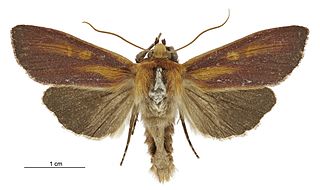Tebenna immutabilis is a moth of the family Choreutidae. It is known from the United States, including California.
Hellinsia venapunctus is a moth of the family Pterophoridae first described by William Barnes and Arthur Ward Lindsey in 1921. It is found primarily in the US state of Texas.

Aristotelia roseosuffusella, the pink-washed aristotelia, clover aristotelia moth or garden webworm, is a moth in the family Gelechiidae. It is found in North America, including Alabama, Georgia, Illinois, Kentucky, Maryland, Massachusetts, Michigan, New Jersey, Oklahoma, Ontario, South Carolina, Tennessee and Virginia. The species was first described by James Brackenridge Clemens in 1860.

Ichneutica purdii, the orange astelia wainscot, is a moth of the family Noctuidae. It is endemic to New Zealand. It can be found throughout the main islands of New Zealand. I. purdii is a relatively large, colourful moth, unlikely to be confused with any other endemic moth species in New Zealand. The larvae of this moth feed at night on species of Astelia. During the day they shelter in the interior of the plant. When fully grown the larvae can reach a length of approximately 48mm. The larvae are ocherous in colour with a pink flush with line markings but when ready to pupate these markings fade and the larvae take on a light golden hue with a rosy tinge to its rear segments. The deep wine coloured pupa is enclosed in a slight cocoon, with this being constructed below the soil, amongst debris or alternatively within a hollow stick. The adult moths are on the wing from October to March. Although this moth is found throughout the main islands of New Zealand it is more frequent in the south of New Zealand at higher altitudes of up to 1200m.
Langsdorfia beatrix is a moth in the family Cossidae. It is found in Guatemala.
Apachea barberella is a moth in the family Depressariidae, and the only species in the genus Apachea. It was described by August Busck in 1902. It is found in North America, where it has been recorded from Montana, Colorado, New Mexico, Arizona, Utah and California.

Eucosma abstemia is a species of moth of the family Tortricidae first described by Edward Meyrick in 1932. It is found in the United States, where it has been recorded from Colorado, Arizona and California.

Dichomeris punctidiscellus, the spotted dichomeris moth, is a moth in the family Gelechiidae. It was described by James Brackenridge Clemens in 1863. It is found in North America, where it has been recorded from southern Quebec, southern Ontario and Nebraska to Florida and south-eastern Texas.
Pseudotelphusa fuscopunctella is a moth of the family Gelechiidae. It is found in North America, where it has been recorded from Arkansas, Florida, Georgia, Illinois, Indiana, Kentucky, Maine, Mississippi, Pennsylvania, New Jersey, South Carolina and West Virginia.
Gelechia discostrigella is a moth of the family Gelechiidae. It is found in North America, where it has been recorded from California.
Gelechia ocherfuscella is a moth of the family Gelechiidae. It is found in North America, where it has been recorded from California.
Gelechia flexurella is a moth of the family Gelechiidae. It is found in North America, where it has been recorded from Pennsylvania.

Aristotelia rubidella is a moth of the family Gelechiidae. It was described by James Brackenridge Clemens in 1860. It is found in North America, where it has been recorded from Alabama, Alberta, Arkansas, British Columbia, California, Florida, Georgia, Illinois, Indiana, Iowa, Kentucky, Louisiana, Maine, Manitoba, Maryland, Massachusetts, Michigan, Mississippi, New Jersey, North Carolina, Ohio, Oklahoma, Ontario, Quebec, South Carolina, Tennessee, Texas, Virginia, Washington, West Virginia and Wisconsin.
Monochroa gilvolinella is a moth of the family Gelechiidae. It was described by James Brackenridge Clemens in 1863. It is found in North America, where it has been recorded from Illinois, Indiana, Mississippi, New Hampshire and Pennsylvania.
Monochroa robusta is a moth of the family Gelechiidae. It was described by Annette Frances Braun in 1921. It is found in North America, where it has been recorded from Ohio and South Carolina.
Chrysoesthia lingulacella, the silver-banded moth, is a moth of the family Gelechiidae. It was described by James Brackenridge Clemens in 1860. It is found in North America, where it has been recorded from Alberta, Arizona, California, Illinois, Indiana, Iowa, Maine, New Hampshire, Quebec and Texas.
Gonionota determinata is a moth in the family Depressariidae. It was described by Clarke in 1964. It is found in Guyana and Venezuela.
Gonionota fimbriata is a moth in the family Depressariidae. It was described by Clarke in 1964. It is found in Panama.
Chlamydastis lactis is a moth in the family Depressariidae. It was described by August Busck in 1911. It is found in the Guianas and Brazil.

Tingena ancogramma is a species of moth in the family Oecophoridae. It is endemic to New Zealand and has been found in the Hen and Chicken Islands, the North Island and the South Island. Adults are on the wing in summer and autumn and inhabit open areas of forest scrubland.





